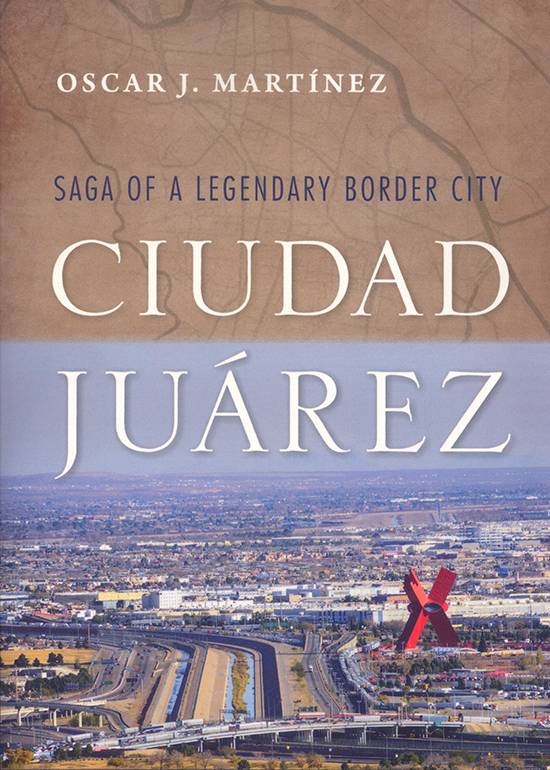By The Rio Grande

Ciudad Juárez: Saga of a Legendary Border City
by Oscar J. Martínez
Tucson: University of Arizona Press, 2018.
330 pp. $29.95 paper.
Reviewed by
Alberto Wilson III
Ciudad Juárez: Saga of a Legendary Border City sees Oscar Martínez revisit his first publication, Border Boom Town: Ciudad Juárez since 1848, and offer updates. A longuee durée synthesis of the economic and political life of Mexico’s most important border city since 1848, periodized as follows: state and national market formation, nationalist-based cooperation and competition, and economic integration. Martínez argues Juárez “has been far more an extension of the U.S. economy,” which “fits within the broader asymmetrical dependency relationship between Mexico and the United States.” Indeed, the work successfully complicates the historiographic cartography of Ciudad Juárez by placing that city’s history within a constellation of local, regional, national, bi-national, and international developments. What emerges is a dynamic, elusive, and, at times, tragic history of a border city with unparalleled influence and widespread notoriety on the global stage.
Beginning with the Mexican-American War, which redrew the political boundaries of North America, Martínez traces how settlers, commerce, and state entities from each nation arrived at respective frontiers throughout the nineteenth century. Whereas Juárez had long commanded the region’s hinterland, the close of the century and the arrival of the railroad in the 1880s transformed the region into an “international trade complex” with a majority of capital concentration in El Paso. The dependency of Mexico’s northern region to the United States led to regional conflict within Mexico as those in the north lobbied for a free trade zone, while those in central and southern Mexico pushed for protectionist tariffs. The collapse of the Mexican state system during the Mexican Revolution (1910-1920) paused those debates as Juárez-El Paso became embroiled in the armed conflict; the former playing theater to various military maneuvers and the latter receiving thousands of fleeing Mexicans.
After tracing the nineteenth-century roots of asymmetrical dependency, Martínez shifts to the five-decade long period beginning in the 1920s where nationalist aspirations chafed and/or coincided with the lived reality on the border. During Prohibition, Juarenses boosters welcomed vice commerce into the central district. Soon, tourists crossed the Santa Fe International Bridge in search of alcohol, gambling, and the occasional sexual liaison. The red lights in Juárez’s central district began to flicker in 1929 and gave-out around 1931 when the Great Depression arrived in the dual-city borderplex. As the money levied on vice tourists parched, Mexican nationalism stirred to life as local leaders promoted the production and purchase of Mexican goods. Ultimately, the United States’ entry into World War II and the post-WWII years helped return economic boon to Juárez. The Mexican state’s adoption of an import-substitution model for growth elevated the nation’s economic indices and quality of life. Consequently, Mexico City officials sought to finally link the northern border with the rest of the nation and in the 1950s designated nearly 149 million pesos to the Programa Nacional Fronterizo. In the end, the modern commercial and cultural facilities of the PRONAF enjoyed mixed success as Juárez’s retention coefficient in 1970 stood at fifty cents out of every dollar.
In the final portion of Saga of a Legendary Border City, Martínez locates Mexico’s move towards neoliberal economic policy to Ciudad Juárez beginning in 1965. That year, Mexico and the United States signed a bilateral agreement, the Border Industrialization Program, which sought to attract manufacturing to Mexico’s northern border region. The initial hope that maquiladoras would turn to Mexican inputs was quickly dashed. In reality, foreign firms introduced their inputs duty-free, assembled their products with low-wage labor, and exported the finished product with only a ten percent tax on the value added. As Ciudad Juárez experienced rapid industrialization, the city also became the center stage of the struggle between the Partido Acción Nacional (or PAN) and the Partido Revolucionario Institucional (or PRI), who for nearly seven decades had monopolized nearly every local, state, and national office. In the final two decades of the twentieth century, economic recessions, the global drop in oil prices, peso devaluations, and economic restructuring pushed Mexico towards the United States’ orbit through the same neoliberal economic policy that had arrived on the border in the mid-1960s.
Saga of a Legendary Border City ends with two chapters that address the devastating violence experienced in Ciudad Juárez from the 1990s into the 2000s. Given the lack of a diverse source base these chapters replicate official Mexican government positions on the recovery in Ciudad Juárez, drug cartel violence, and collusion. Still, Martínez effectively places the conflagration of violence within a context of a city that experienced spurious economic growth while simultaneously abandoning many of its marginalized residents. The reserve army of labor that had kept wages in Ciudad Juárez at a paltry $4.50 starting daily wage in 2006 turned into a ready pool of sicarios for drug cartels during their offensive from 2000 to 2011. Despite recent history in Juárez, the city’s social fabric has been restored substantially. Storefronts in the PRONAF are attracting customers, beautification projects in the central district draw crowds in search of old, Prohibition era Juárez, and Pope Francis’s visit restored hope and promise to residents.
Oscar Martínez’s work, Ciudad Juárez: Saga of a Legendary Border City and career-long commitment to scholarship on the U.S.-Mexico borderlands remind scholars and readers alike that the past, present, and future of North America, Mexico and the United States, and Ciudad Juárez and El Paso are intricately connected.
Alberto Wilson III is a PhD Student at the University of Houston specializing in Latino/a, borderlands, and modern American history. His research explores questions of class, commerce, and community on the border.
